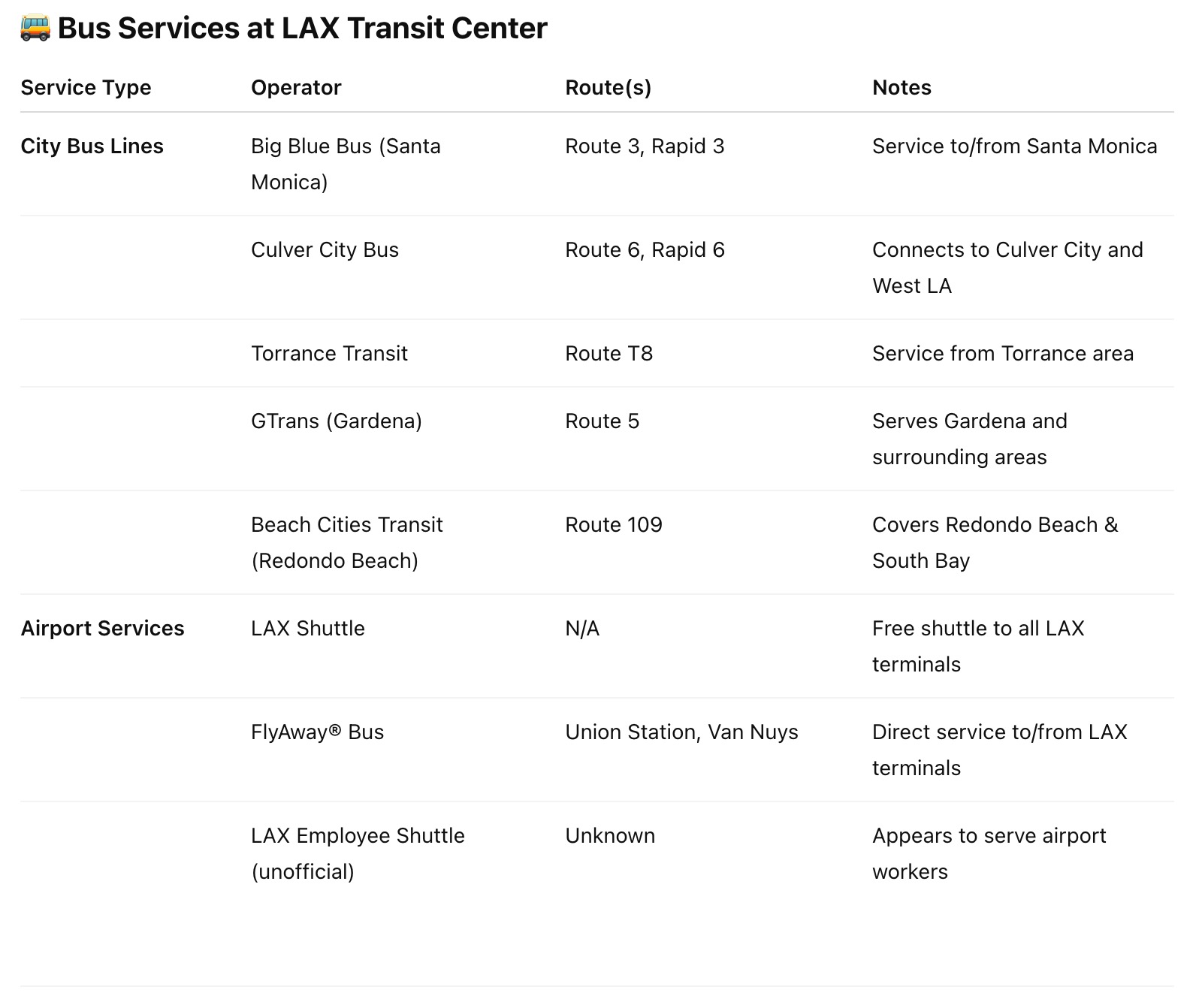Comments
LA TRANSPO - Unlike major airports around the U.S., and the world, LAX lacks a train, or subway, which runs directly into the airport. The new LAX Transit Center, which carried great hopes for efficient transit travel after forty years of debates, myths, delays, confusion, lack of coordination between Metro and LAWA/LAX, possible confusion to airline pilots, possible electronic interference, and the list goes on, does not improve assisting city bus riders.
In a recent City Watch article Nick Patsaouras lays out the argument that an earlier iteration of Metro had plans drawn for this project, but LAWA/LAX was not ready and cancelled the project. Pity.
It seems LAWA/LAX is never ready to deliver quality experiences to jet travelers, and it may not raise its profile with the new LAX Transit Center. Skytrax with rating as recent as April 2025, gives a good idea of the low impressions of LAX-Ratings.
The LAX Transit Center is hoped to alleviate the ever growing traffic nightmare of the LAX horseshoe serving the airlines. Year after year, traffic inside the airport horseshoe traffic becomes worse, and spills onto the streets around the airport.
In my experiences of attending Metro sponsored meetings on a train or subway directly into LAX, I remember two arguments against it: 1. A subway was considered, but due to the small footprint of this very busy airport there are too many underground utilities and spaces to fit a subway. 2. An elevated light rail train, though narrower than larger and heavier heavy rail trains, was still too large to maneuver within the narrow confines of the airport.
Fair enough. So, to somehow get some type of train on tracks into LAX terminals, leaders developed a plan for an automated people mover, smaller than a light rail train.
However, to get to the people mover transit riders would take either one of the many city buses which serve the airport to the LAX Transit Center, or take the Metro light rail trains C/Green or K/Crenshaw Lines. Finally, the mythical beast of no train into LAX seems to have been slain.
But the situation is not running so smoothly. The K/Crenshaw Line and C/Green Line both serve the LAX Transit Center, which opened June 6, 2025, but the people mover is not completed.
The elevated tracks are completed, and some of the trains cars are here, but it could be another year before this marriage between Metro light rail trains and city buses, and the LAWA/LAX people mover tie the knot, and function as a unit.
There has been bad blood between LAWA and the builder of the people mover, LAX Integrated Express Solutions, with the latter suing the former. Los Angeles City Council allowed first $400Million to settle things, and then an additional $200Million to resolve claims. The total budget for the project is slated at $2.9Billion.
The scheduled date for operations to start is 2026.
With much fanfare Metro opened the LAX Transit Center June 9, 2025.
As a transit rider since 1993 to reduce my carbon footprint, I mostly ride Metro, Culver City and Santa Monica Buses. I ride mostly the E/Expo and K/Crenshaw Lines, but have ridden all Metro Lines.
I have ridden many miles and have sat in many buses and trains. Sometimes things work out, other times they don’t.
I had great expectations for the LAX Transit Center. After using the new LAX Transit Center strictly as a transit rider, my expectations have been sorely diminished. This transit center will become part of my regular commute, but it wastes my time.
I missed the grand opening of the LAX Transit Center on June 6, 2025, because the surrounding hoopla would not provide a real life, real commute experience. So, on separate occasions rode the Expo Line to the Crenshaw Line to the LAX Transit Center and then transferred to a Culver City 6 in the new transit center’s bus bay. (More on that name follows.)
From the K/Crenshaw Line southbound after exiting onto the LAX Transit Center I was on an at-ground platform, on the same level as the city bus bay which I just passed, and could see to my left. And while I could see some city buses, I could not just walk over to the city bus bay.
It was disorientating exiting the Crenshaw Line train and stepping on to the ground level of the transit center. I looked for signs for the city buses. Disclosure-it seems the nomenclature of Metro, and maybe LAWA/LAX, is just “bus,” I will use “city bus,” to try to differentiate between the many buses serving the LAX Transit Center. I find “city bus” more inviting, more urbane, even more personal than just “bus.” In a recent news segment on exhaust from idling vehicles, New York City calls them “city bus.” This should be incorporated into the lexicon for SoCal transit agencies.
 •
•
With this number of city buses and other buses, when first using the LAX Transit Center even with decades of experience riding buses in Los Angeles I found it extremely confusing. Consider those new to L.A. transit, and their heads will spin. Consider the faster head rotation from visitors from other parts of the state or nation, and the very high speed head spin from those outside the country whose native language is not English in trying to decipher signs to get to their city bus.
With the cold war between LAWA/LAX and the builder of the people mover, LAX Integrated Express Solutions, it is easy to surmise that relationships between LAWA/LAX and Metro may have had some moments.
There seems no one clear set of directions for transit rider. At the transit center there are different signs for city bus riders, one has “Bus Plaza,” another the other “Bus Bay,” and the just “Bus.” Which one is it?
For anyone looking for instructions on where to go to catch a city bus, this is just sloppy work. It is careless, creating chaos and anxiety for those trying to find out which city bus to take to get to their destination.
On the floors of this transit center next to each other are large, circular decals, one with a pointing arrow, the other with the icon of a passenger jet. That is fine for those getting on a jet, but useless for transit riders trying to find a city bus.
Why are there no decals with the pointing arrow and icon for the city buses? Could no one in all of the agencies involved for this project think about city bus riders?
Is the official characterization of city bus riders so low in the corporate structures of LAWA/LAX and Metro and elsewhere that we do not warrant our own decals for directions to the city bus to continue our travels?
To top off matters, once the city bus rider exits a Metro Rail train we cannot just stay on-ground and walk to a city bus. We must take either an escalator, elevator or climbs stairs to the next level up, so our journey is not done. We then use the TAP card to go through turnstiles with doors, and then descend back down by escalator, elevator or stairs to the ground level where we first exited the Metro Rail train to get to the Bus Bay, or Bus Plaza, or Bus, to finally catch our city bus. This wastes a lot of time, and if someone has to transfer from that city bus to another city bus or rail, that lost time creates a new set of obstacles in riding transit.
This climbing and then descending levels to transfer from Metro Rail to a city bus may be a safety issue. The up and down is to cross-over a Metro Rail line. At other Metro Rail stations there crossing guards to keep riders from crossing tracks as a train passes. Could that have worked here?
Maybe it was too much for officials to think transit riders are capable of the understanding that when the crossing guard is down, we do not cross the tracks. If the crossing guard is up, we cross the tracks. We follows those instructions all the time.
Is it that LAWA/LAX and Metro did not want the noise of the crossing guard arms inside the transit center? Or were there rules for safety demanded from the Federal Transit Administration (FTA), the agency within the U.S. Department of Transportation (DOT) that supports transit systems nationwide, including light rail, through funding, technical assistance, and oversight of safety. It is unknown.
Either way, or whatever the reason, city bus riders seem to be an afterthought to LAWA/LAW, and Metro, and whomever else planned this transit center which is not city bus rider friendly.
The LAX Transit Center itself is a wonderful structure with curving lines to soften the look. It is large, and with open sides and ceilings, it feels inviting. This lets the prevalent on-shore breeze wash through the center. But it also lets in an occasional whiff of kerosene from the jets on the runway.
The LAX Transit Center is mostly white, which gets boring. Inside the transit center is a bank of four escalators, and for my three trips there no one rode any of them. At the top landing is a large mercurial sculpture of animals hanging above. It is also white, and gets lost in the surroundings. I don’t know if this was the artist’s own inspiration, or they worked from all-white directions from LAWA/LAX or Metro.
The LAX Transit Center is smartly planted with drought tolerant landscaping. It is very attractive, and the dryness of the xeriscaping landscape feels very appropriate for the dry SoCal climate.
But frustratingly, the design nor landscape of the LAX Transit Center negate the obstacles and time wasting routes for transit riders, and those departing planes, who are trying to get to a city bus at the Bus Bay, or is it Bus Plaza, or just plain Bus.
Much of the improvement of the negative impressions of LAX hang on the LAX Transit Center, and how this facility treats bus riders may not move the needle into positive. Until the People Mover opens, how plane travelers will react is unknown.
I will use the LAX Transit Center as part of my transit commutes, and grumble at my time wasted to get to a city bus.
(Matthew Hetz is a Los Angeles native, a composer whose works have been performed nationally, and some can be found here. He is the past President of the Culver City Symphony Orchestra and Marina del Rey Symphony. His dedication to transit issues is to help improve the transit riding experience for all, and to convince drivers to ride buses and trains to fight air pollution and global warming. He is an instructor at Emeritus/Santa Monica College and a regular contributor to CityWatchLA.)
















